Triton: Topography and Geology of a Probable Ocean World with Comparison to Pluto and Charon
Abstract
:1. Introduction
2. Materials and Methods
2.1. Geometric Registration and Control Network
2.2. Deriving Topography of Triton
2.3. Limb Profiles and Match Point Radii
2.4. Stereogrammetry
2.5. Match Point Radii Solutions
2.6. Photoclinometry
2.7. Smeared Images
2.8. Stereo-Controlled Photoclinometry (SG-PC)
2.9. Using the Topographic Data
3. Results: Topographic Characteristics of Geologic Units and Structures
- SG_DEM corresponding to VTERM CA mosaic (Figure 3) at vertical precisions of ~300–1000 m.
- PC_DEM covering most of the terminator region of the Voyager 2 encounter (sub-Neptune) hemisphere (Figure 6) at 1.2–0.6 km/pxl, covering ~8% of the surface, used for smaller geologic features.
- Stereo-controlled version of the PC_DEM corresponding to the VTERM CA mosaic coverage area (Figure 8).
- Sparse match point radius estimates extended over ~40% of the surfaces, mainly over southern terrains (Figure 8).
3.1. Cantaloupe Terrain
3.2. Ridges
3.3. Walled Planitia
3.4. Resurfaced (Volcanic) Plains of Cipango Planum
3.5. Paterae
3.6. Etched Plains and Landform Degradation
3.7. Southern Hemisphere Terrains
4. Triton-Pluto-Charon Contrasts
5. Global Topographic Characteristics of Triton
6. Discussion and Conclusions
- The amplitude of geologic features (knobs, scarps, pits, ridges, etc.) is, with very few exceptions, <1 km;
- diapiric and volcanic terrains exhibit relief of <1 km;
- southern hemisphere terrains (both macular and lineated terrains) exhibit relief of <1 km, and possibly less;
- bright lobate terrains in the southern hemisphere south of ~45° S latitude appear to embay other terrains and may be topographically controlled volatile ices, but no reliable topography exists;
- bright lobate terrains may correlate with detached atmospheric hazes;
- no large-scale areas of mountainous terrain or deep basins of >1 km amplitude occur within the illuminated Voyager 2 encounter hemisphere;
- cantaloupe cells (or cavi) exhibit 300–500 m of negative relief and may be shallower where embayed by smooth volcanic materials to the north.
Author Contributions
Funding
Data Availability Statement
Acknowledgments
Conflicts of Interest
Appendix A. Errors and Uncertainties in Topography
References
- Prockter, L.M.; Mitchell, K.L.; Howett, C.J.A.; Smythe, W.D.; Sutin, B.M.; Bearden, D.A.; Frazier, W.E. Exploring Triton with Trident: A Discovery Class Mission. In Proceedings of the 50th Lunar and Planetary Science Conference, LPI, Woodlands, TX, USA, 18–22 March 2019. [Google Scholar]
- Rymer, A.; Clyde, B.; Runyon, K. Neptune Odyssey: Mission to the Neptune-Triton System. NASA Planetary Mission Concept Study. 2020. Available online: https://science.nasa.gov/files/science-red/s3fs-public/atoms/files/Neptune%20Odyssey.pdf (accessed on 15 May 2021).
- Gaeman, J.; Hier-Majumder, S.; Roberts, J.H. Sustainability of a subsurface ocean within Triton’s interior. Icarus 2012, 220, 339–347. [Google Scholar] [CrossRef]
- Hendrix, A.R.; Hurford, T.A.; Barge, L.M.; Bland, M.T.; Bowman, J.; Brinckerhoff, W.; Buratti, B.J.; Cable, M.; Castillo-Rogez, J.; Collins, G.; et al. The NASA roadmap to ocean worlds. Astrobiology 2019, 19, 1–27. [Google Scholar] [CrossRef] [PubMed] [Green Version]
- Smith, B.A.; Soderblom, L.A.; Banfield, D.; Basilevsky, A.T.; Beebe, R.F.; Bollinger, K.; Boyce, J.M.; Brahic, A.; Briggs, G.A.; Brown, R.H.; et al. Voyager 2 in the neptunian system: Imaging science results. Science 1989, 246, 1422–1449. [Google Scholar] [CrossRef] [PubMed] [Green Version]
- Croft, S.K.; Kargel, J.S.; Kirk, R.L.; Moore, J.M.; Schenk, P.M.; Strom, R.G. The geology of Triton. In Neptune and Triton; University of Arizona Press: Tucson, AZ, USA, 1995; pp. 879–947. [Google Scholar]
- Stern, S.A.; McKinnon, W.B. Triton’s surface age and impactor population revisited in light of Kuiper Belt fluxes: Evidence for small Kuiper Belt objects and recent geological activity. Astron. J. 2000, 119, 945. [Google Scholar] [CrossRef] [Green Version]
- Schenk, P.M.; Zahnle, K. On the negligible surface age of Triton. Icarus 2007, 192, 135–149. [Google Scholar] [CrossRef]
- Schenk, P.; Jackson, M.P.A. Diapirism on Triton: A record of crustal layering and instability. Geology 1993, 21, 299–302. [Google Scholar] [CrossRef]
- Soderblom, L.A.; Kieffer, S.W.; Becker, T.L.; Brown, R.H.; Cook, A.F.I.; Hansen, C.J.; Johnson, T.V.; Kirk, R.L.; Shoemaker, E.M. Triton’s Geyser-Like Plumes: Discovery and Basic Characterization. Science 1990, 250, 410–415. [Google Scholar] [CrossRef] [PubMed] [Green Version]
- Hansen, C.J.; McEwen, A.S.; Ingersoll, A.P.; Terrile, R.J. Surface and Airborne Evidence for Plumes and Winds on Triton. Science 1990, 250, 421–424. [Google Scholar] [CrossRef]
- Kirk, R.L.; Soderblom, L.A.; Brown, R.H.; Kieffer, S.W.; Kargel, J.S. Triton’s plumes: Discovery, characteristics, and models. In Neptune and Triton; Cruikshank, D.P., Matthews, M.S., Schumann, A.M., Eds.; University of Arizona Press: Tucson, AZ, USA, 1995; pp. 949–989. [Google Scholar]
- Hussmann, H.; Sohl, F.; Spohn, T. Subsurface oceans and deep interiors of miedium-sized outer planet satellites and large Trans-Neptunian objects. Icarus 2006, 195, 258–273. [Google Scholar] [CrossRef]
- Nimmo, F.; Spencer, J.R. Powering Triton’s recent geological activity by obliquity tides: Implications for Pluto geology. Icarus 2015, 246, 2–10. [Google Scholar] [CrossRef] [Green Version]
- Cruikshank, D.P. Triton, Pluto, Centaurs, and trans-neptunian bodies. Space Sci. Rev. 2005, 116, 421–439. [Google Scholar] [CrossRef] [Green Version]
- Cruikshank, D.P.; Roush, T.L.; Owen, T.C.; Geballe, T.R.; de Bergh, C.; Schmitt, B.; Brown, R.H.; Bartholomew, M.J. Ices on the surface of Triton. Science 1993, 261, 742–745. [Google Scholar] [CrossRef]
- Grundy, W.M.; Young, L.A.; Stansberry, J.A.; Buie, M.W.; Olkin, C.B.; Young, E.F. Near-infrared spectral monitoring of Triton with IRTF/SpeX II: Spatial distribution and evolution of ices. Icarus 2010, 205, 594–604. [Google Scholar] [CrossRef] [Green Version]
- Bierson, C.J.; Nimmo, F.; Stern, S.A. Evidence for a hot start and early ocean formation on Pluto. Nat. Geosci. 2020, 13, 468–472. [Google Scholar] [CrossRef]
- Schenk, P.M.; Beyer, R.A.; McKinnon, W.B.; Moore, J.M.; Spencer, J.R.; White, O.L.; Singer, K.; Nimmo, F.; Thomason, C.; Lauer, T.R.; et al. Basins, fractures and volcanoes: Global cartography and topography of Pluto from New Horizons. Icarus 2018, 314, 400–433. [Google Scholar] [CrossRef]
- Schenk, P.M.; Beyer, R.A.; McKinnon, W.B.; Moore, J.M.; Spencer, J.R.; White, O.L.; Singer, K.; Umurhan, O.M.; Nimmo, F.; Lauer, T.R.; et al. Breaking up is hard to do: Global cartography and topography of Pluto’s mid-sized icy moon Charon from New Horizons. Icarus 2018, 315, 124–145. [Google Scholar] [CrossRef]
- Schenk, P. Icy Moons. Triton. 2014. Available online: https://www.lpi.usra.edu/icy_moons/neptune/triton/ (accessed on 15 May 2021).
- Martin, E.; Patthoff, A. Mapping Neptune’s Moon Triton. Planetary Geologic Mappers 2020. (LPI Contrib. No. 2357). 2020. Available online: https://www.hou.usra.edu/meetings/pgm2020/pdf/7024.pdf (accessed on 15 May 2021).
- Thomas, P.C. The shape of Triton from limb profiles. Icarus 2000, 148, 587–588. [Google Scholar] [CrossRef]
- Schenk, P.; Moore, J. Topography and geology of Uranian mid-sized icy satellites in comparison with Saturnian and Plutonian satellites. Phil. Trans. R. Soc. A 2020, 378, 2020102. [Google Scholar] [CrossRef] [PubMed]
- Schenk, P.; Williams, D. A Potential Thermal Erosion Lava Channel on Io. Geophys. Res. Lett. 2004, 31, L23702. [Google Scholar] [CrossRef] [Green Version]
- Lee, G.; McGlone, L. Manual of Photogrammetry; American Society for Photogrammetry and Remote Sensing: Bethesda, MD, USA, 2013. [Google Scholar]
- Bierhaus, E.B.; Schenk, P.M. Constraints on Europa’s surface properties from primary and secondary crater morphology. J. Geophys. Res. 2010, 115, E12004. [Google Scholar] [CrossRef] [Green Version]
- McEwen, A. Photometric functions for photoclinometry and other applications. Icarus 1991, 92, 298–311. [Google Scholar] [CrossRef]
- Helfenstein, P.; Veverka, J.; McCarthy, D.; Lee, P.; Hillier, J. Large Quasi-Circular Features Beneath Frost on Triton. Science 1992, 225, 824–826. [Google Scholar] [CrossRef]
- Flynn, B.; Stern, S.A.; Buratti, B.; Schenk, P. The spatial distribution of UV-absorbing regions on Triton. Planet Space Sci. 1996, 44, 1039–1046. [Google Scholar] [CrossRef]
- Ohara, S.; Dombard, A. Simulating formation of Triton’s cantaloupe terrain by compositional diapirs. In Proceedings of the 50th Lunar and Planetary Science Conference, Houston, TX, USA, 18–22 March 2019. [Google Scholar]
- Hammond, N.P.; Parmenteir, E.M.; Barr, A.C. Compaction and melt transport in ammonia-rich ice shells: Implications for the evolution of Triton. J. Geophys. Res. Planets 2018, 123, 3105–3118. [Google Scholar] [CrossRef]
- Prockter, L.; Nimmo, F.; Pappalardo, R. A shear heating origin for ridges on Triton. Geophys. Res. Lett. 2005, 32, L14202. [Google Scholar] [CrossRef] [Green Version]
- Monot, M.; Honoré, N.; Garnier, T.; Araoz, R.; Coppée, J.-Y.; Lacroix, C.; Sow, S.; Spencer, J.S.; Truman, R.W.; Williams, D.L.; et al. The geology of Pluto and Charon through the eyes of New Horizons. Science 2016, 351, 1284–1293. [Google Scholar] [CrossRef] [Green Version]
- Beyer, R.A.; Spencer, J.R.; McKinnon, W.B.; Nimmo, F.; Beddingfield, C.; Grundy, W.M.; Ennico, K.; Keane, J.T.; Moore, J.M.; Olkin, C.B.; et al. The nature and origin of Charon’s smooth plains. Icarus 2019, 323, 16–32. [Google Scholar] [CrossRef]
- Robbins, S.J.; Beyer, R.A.; Spencer, J.R.; Grundy, W.M.; White, O.L.; Singer, K.N.; Moore, J.M.; Dalle Ore, C.M.; McKinnon, W.B.; Lisse, C.M.; et al. Geologic Landforms and Chronostratigraphic History of Charon as Revealed by a Hemispheric Geologic Map. J. Geophys. Res. 2019, 124, 155–174. [Google Scholar] [CrossRef]
- Quick, L. New analysis of rheology of cryolava flows in Vulcan Planitia. In Proceedings of the Pluto after New Horizons Meeting, Laurel, MD, USA, 14–18 July 2019. [Google Scholar]
- Macdonald, G.A. Pahoehoe, aa, and block lava. Am. J. Sci. 1953, 251, 169–191. [Google Scholar] [CrossRef]
- Fink, J.; Griffiths, R. Morphology, eruption rates, and rheology of lava domes: Insights from laboratory models. J. Geophys. Res. 1998, 103, 527–545. [Google Scholar] [CrossRef]
- Howard, A.D.; Moore, J.M.; White, O.L.; Umurhan, O.M.; Schenk, P.M.; Grundy, W.; Schmitt, B.; Philippe, S.; McKinnon, W.B.; Spencer, J.R.; et al. Pluto: Pits and mantles on uplands north and east of Sputnik Planitia. Icarus 2017, 293, 218–230. [Google Scholar] [CrossRef]
- Jingyi, M.; Brasser, R. The origin of the cratering asymmetry on Triton. Mon. Not. R. Astron. Soc. 2019, 486, 836–842. [Google Scholar]
- Bertrand, T.; Forget, F. Observed glacier and volatile distribution on Pluto from atmosphere-topography processes. Nature 2016, 540, 86–89. [Google Scholar] [CrossRef]
- Hofgartner, J. Hypotheses for Triton’s Plumes: New Analyses and Spacecraft Remote Sensing Tests. Remote. Sens. 2021, submitted. [Google Scholar]
- Holler, B.J.; Young, L.A.; Grundy, W.M.; Olkin, C.B. On the surface composition of Triton’s southern latitudes. Icarus 2016, 267, 255–266. [Google Scholar] [CrossRef] [Green Version]
- Moore, J.M.; Spencer, J.R. Koyaanismuuyaw: The hypothesis of a perennially dichotomous Triton. Geophys. Res. Lett. 1990, 17, 1757–1760. [Google Scholar] [CrossRef]
- McKinnon, W.B. On the origin of Triton and Pluto. Nature 1984, 311, 355–358. [Google Scholar] [CrossRef]
- Moore, J.M.; Howard, A.D.; Schenk, P.M.; McKinnon, W.B.; Pappalardo, R.T.; Ewing, R.C.; Bierhaus, E.B.; Bray, V.J.; Spencer, J.R.; Binzel, R.P.; et al. Geology before Pluto: Pre-encounter considerations. Icarus 2015, 246, 65–81. [Google Scholar] [CrossRef] [Green Version]
- Agnor, C.B.; Hamilton, D.P. Neptune’s capture of its moon Triton in a binary-planet gravitational encounter. Nature 2006, 441, 192–194. [Google Scholar] [CrossRef]
- Nogueira, E.; Brasser, R.; Gomes, R. Reassessing the origin of Triton. Icarus 2011, 214, 113–130. [Google Scholar] [CrossRef] [Green Version]
- Canup, R.M. A giant impact origin of Pluto-Charon. Science 2005, 307, 546–550. [Google Scholar] [CrossRef] [Green Version]
- Canup, R.M. On a giant impact origin of Charon, Nix, and Hydra. Astron. J. 2011, 141, 35. [Google Scholar] [CrossRef]
- Grundy, W.M.; Binzel, R.P.; Buratti, B.J.; Cook, J.C.; Cruikshank, D.P.; Ore, C.M.D.; Earle, A.M.; Ennico, K.; Howett, C.J.A.; Lunsford, A.W.; et al. Surface compositions across Pluto and Charon. Science 2016, 351, aad9189. [Google Scholar] [CrossRef] [Green Version]
- Singer, K.N.; Schenk, P.M.; McKinnon, W.B.; Beyer, R.A.; Schmitt, B.; White, O.L.; Moore, J.M.; Grundy, W.; Spencer, J.; Stern, S.A.; et al. Large-scale cryovolcanic resurfacing on Pluto. Nat. Commun. 2021. in revision. [Google Scholar]
- Singer, K.N.; McKinnon, W.B.; Gladman, B.; Greenstreet, S.; Bierhaus, E.B.; Stern, S.A.; Parker, A.H.; Robbins, S.J.; Schenk, P.M.; Grundy, W.M.; et al. Impact craters on Pluto and Charon indicate a deficit of small Kuiper belt objects. Science 2019, 363, 955–959. [Google Scholar] [CrossRef] [Green Version]
- Schenk, P.; Moore, J. Volcanic constructs on Ganymede and Enceladus: Topographic evidence from stereo images and photoclinometry. J. Geophys. Res. 1995, 100, 19009–19022. [Google Scholar] [CrossRef]
- Schenk, P.; White, O.; Moore, J.; Byrne, P. Geology of Saturn’s other icy moons. In Enceladus and the Icy Moons of Saturn; University of Arizona Press: Tucson, AZ, USA, 2018; pp. 237–265. [Google Scholar]
- Sheth, H.C.; Ray, J.S.; Kumar, A.; Bhutani, R.; Awasthi, N. Toothpaste lava from the Barren Island volcano (Andaman Sea). J. Volcanol. Geotherm. Res. 2011, 202, 73–82. [Google Scholar] [CrossRef]
- Plescia, J.B.; Spudis, P.D. Impact melt flows at Lowell crater. Planet. Space Sci. 2014, 103, 219–227. [Google Scholar] [CrossRef]
- McKinnon, W.B.; Nimmo, F.; Wong, T.; Schenk, P.M.; White, O.L.; Roberts, J.H.; Moore, J.M.; Spencer, J.R.; Howard, A.D.; Umurhan, O.M.; et al. Convection in a volatile nitrogen-ice-rich layer drives Pluto’s geological vigour. Nature 2016, 534, 82–86. [Google Scholar] [CrossRef] [PubMed] [Green Version]
- Trowbridge, A.; Melosh, H.J.; Steckloff, J.; Freed, A. Vigourous convection as the explanation for Pluto’s polygonal terrain. Nature 2016, 534, 79–81. [Google Scholar] [CrossRef] [PubMed]
- Protopapa, S.; Grundy, W.; Reuter, D.; Hamilton, D.; Ore, C.D.; Cook, J.; Cruikshank, D.; Schmitt, B.; Philippe, S.; Quirico, E.; et al. Pluto’s global surface composition through pixel-by-pixel Hapke modeling of New Horizons Ralph/LEISA data. Icarus 2017, 287, 218–228. [Google Scholar] [CrossRef] [Green Version]
- Hofgartner, J.D.; Buratti, B.J.; Devins, S.L.; Beyer, R.A.; Schenk, P.; Stern, S.A.; Weaver, H.A.; Olkin, C.B.; Cheng, A.; Ennico, K.; et al. A search for temporal changes on Pluto and Charon. Icarus 2018, 302, 273–284. [Google Scholar] [CrossRef] [Green Version]
- White, O.; Schenk, P.; Nimmo, F.; Hoogenboom, T. A new stereo topographic map of Io: Implications for geology from global to local scales. J. Geophys. Res. 2014, 119, 1276–1301. [Google Scholar] [CrossRef]
- Schenk, P.; McKinnon, W. One-hundred-km-scale basins on Enceladus: Evidence for an active ice shell. Geophys. Res. Lett. 2009, 36, L16202. [Google Scholar] [CrossRef]
- Corliez, P.; Hayes, A.; Birch, S.; Lorenz, R.; Stiles, B.; Kirk, R.; Poggiali, V.; Zebker, H.; Iess, L. Titan’s topography and shape at the end of the Cassini mission. Geophys. Res. Lett. 2017, 44, 11754–11761. [Google Scholar] [CrossRef] [Green Version]
- Kamata, S.; Nimmo, F.; Sekine, Y.; Kuramoto, K.; Noguchi, N.; Kimura, J.; Tani, A. Pluto’s ocean is capped and insulated by gas hydrates. Nat. Geosci. 2019, 12, 407–410. [Google Scholar] [CrossRef]
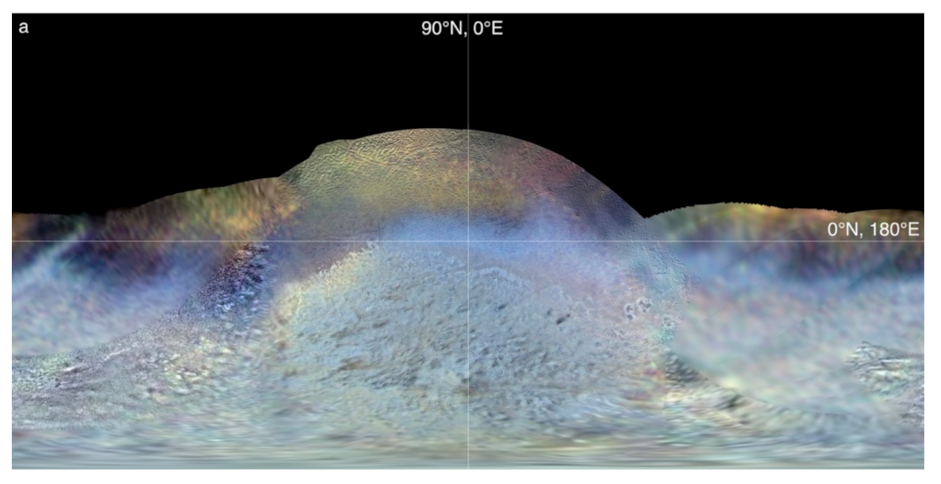










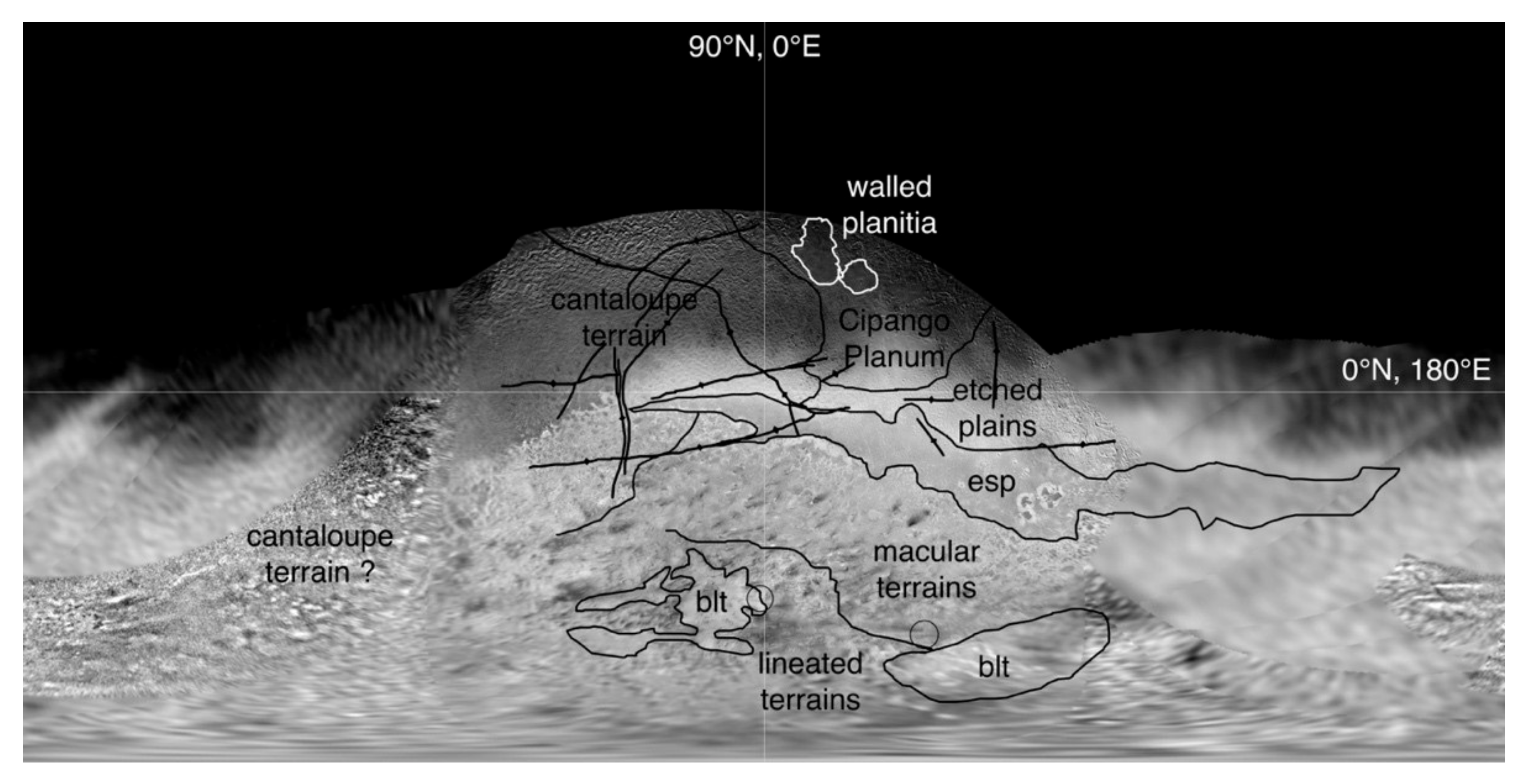



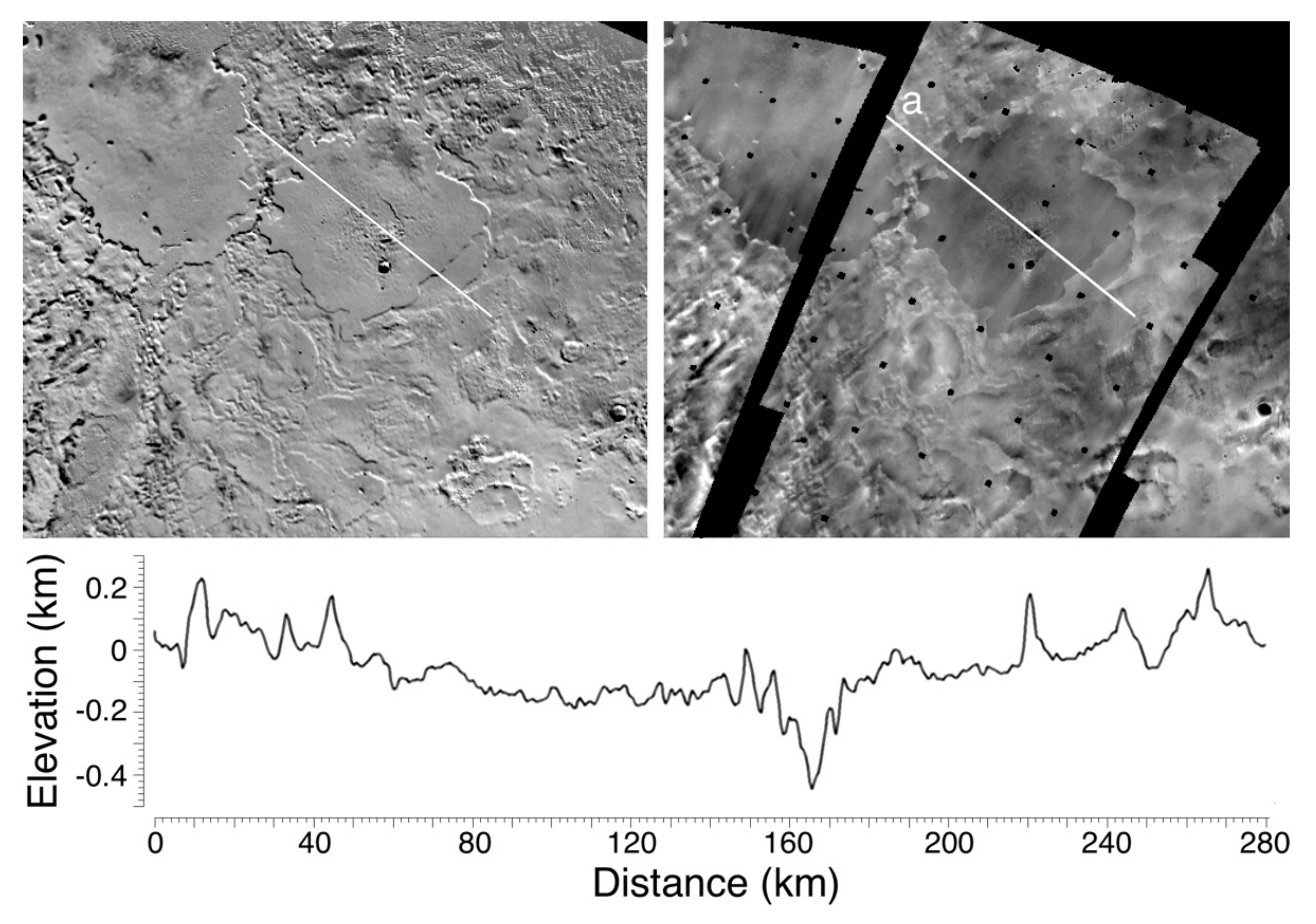





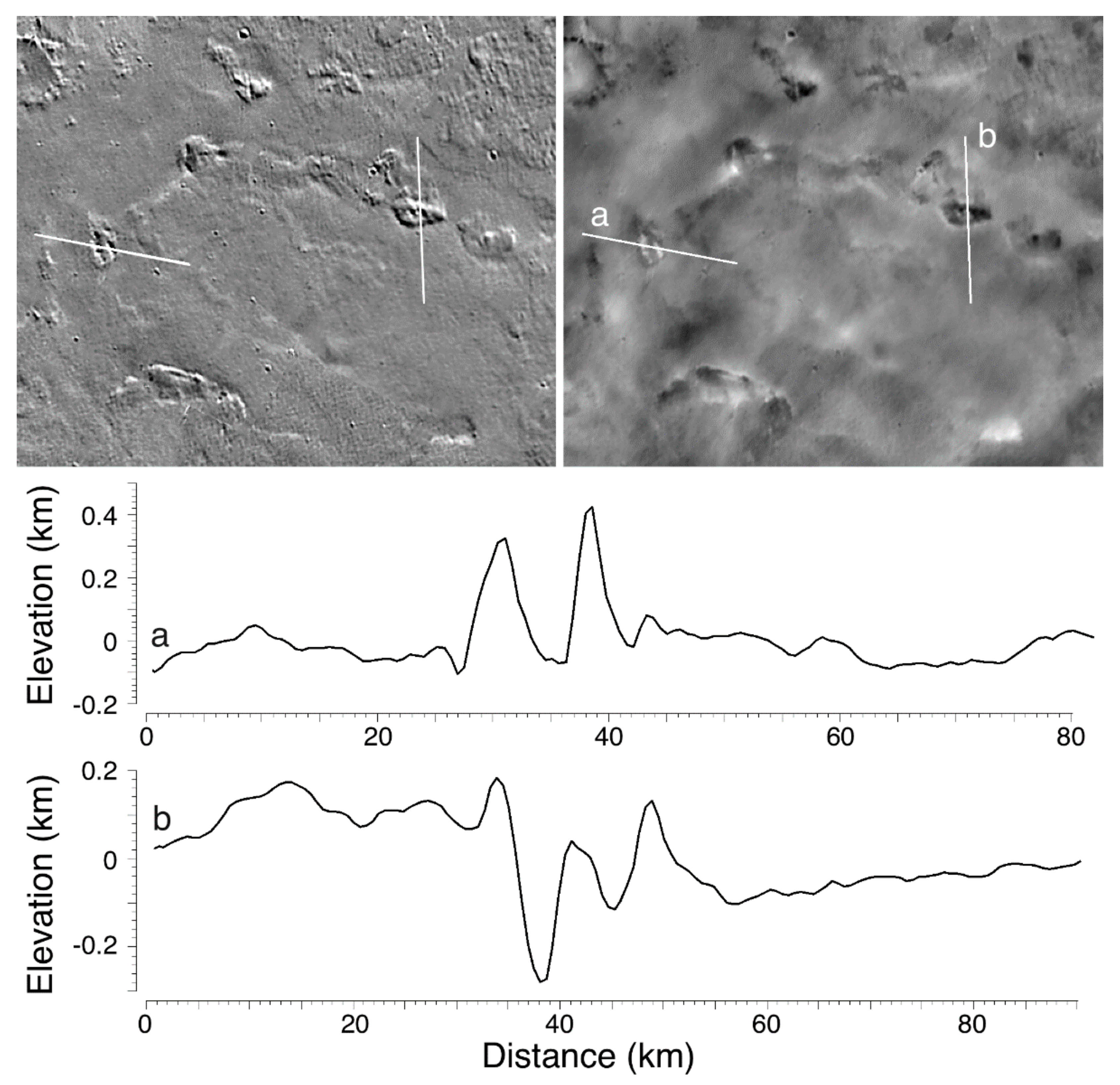


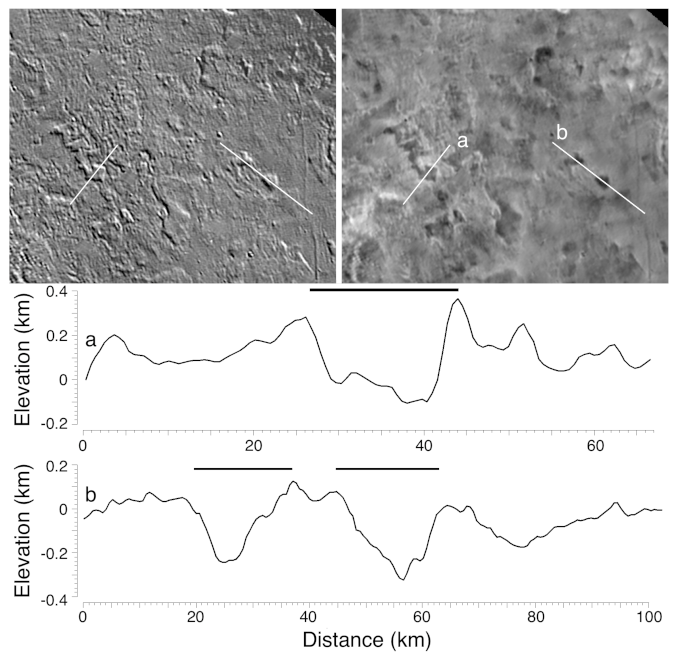




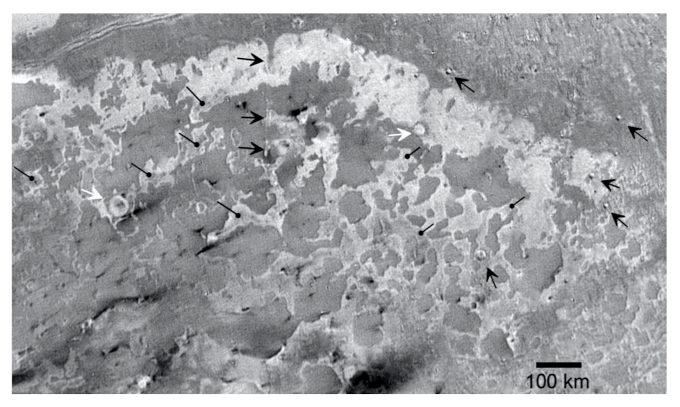

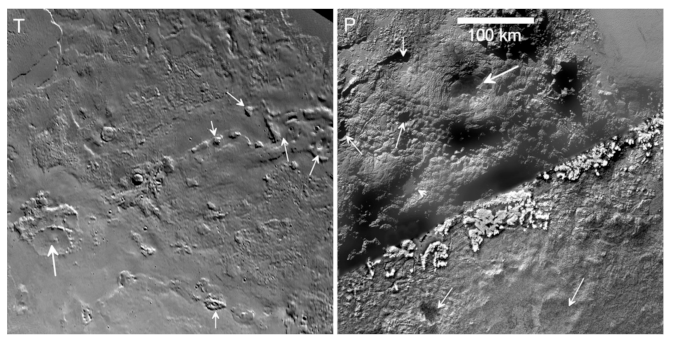



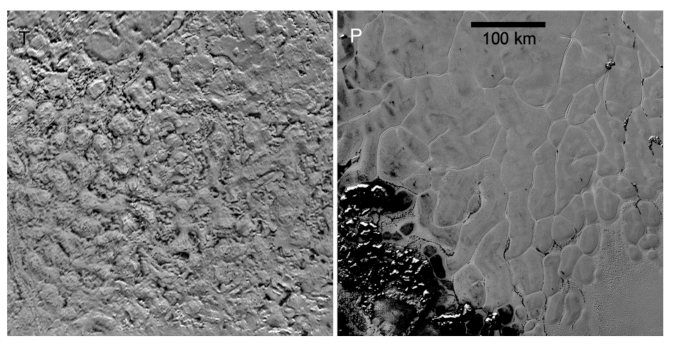


Publisher’s Note: MDPI stays neutral with regard to jurisdictional claims in published maps and institutional affiliations. |
© 2021 by the authors. Licensee MDPI, Basel, Switzerland. This article is an open access article distributed under the terms and conditions of the Creative Commons Attribution (CC BY) license (https://creativecommons.org/licenses/by/4.0/).
Share and Cite
Schenk, P.M.; Beddingfield, C.B.; Bertrand, T.; Bierson, C.; Beyer, R.; Bray, V.J.; Cruikshank, D.; Grundy, W.M.; Hansen, C.; Hofgartner, J.; et al. Triton: Topography and Geology of a Probable Ocean World with Comparison to Pluto and Charon. Remote Sens. 2021, 13, 3476. https://doi.org/10.3390/rs13173476
Schenk PM, Beddingfield CB, Bertrand T, Bierson C, Beyer R, Bray VJ, Cruikshank D, Grundy WM, Hansen C, Hofgartner J, et al. Triton: Topography and Geology of a Probable Ocean World with Comparison to Pluto and Charon. Remote Sensing. 2021; 13(17):3476. https://doi.org/10.3390/rs13173476
Chicago/Turabian StyleSchenk, Paul M., Chloe B. Beddingfield, Tanguy Bertrand, Carver Bierson, Ross Beyer, Veronica J. Bray, Dale Cruikshank, William M. Grundy, Candice Hansen, Jason Hofgartner, and et al. 2021. "Triton: Topography and Geology of a Probable Ocean World with Comparison to Pluto and Charon" Remote Sensing 13, no. 17: 3476. https://doi.org/10.3390/rs13173476
APA StyleSchenk, P. M., Beddingfield, C. B., Bertrand, T., Bierson, C., Beyer, R., Bray, V. J., Cruikshank, D., Grundy, W. M., Hansen, C., Hofgartner, J., Martin, E., McKinnon, W. B., Moore, J. M., Robbins, S., Runyon, K. D., Singer, K. N., Spencer, J., Stern, S. A., & Stryk, T. (2021). Triton: Topography and Geology of a Probable Ocean World with Comparison to Pluto and Charon. Remote Sensing, 13(17), 3476. https://doi.org/10.3390/rs13173476





